[It is better to arrange the sequence in chronological order, since we are in the integrative section.]
[In the TOC entry it should read
TOC A;extract-TOC;C
not
TOC A;deposition;C]
[Please use {data-toc-label=”“} to reduce length of entry for left hand side – ask me if you have not used it before]
Back to top: Chronology
Introduction
In this section one will find the depositional history as we understand it, i.e., the unfolding of events that characterized the development through time of J5. This section is explicitly interpretive, and it reflects exclusively our understanding, as it was arrived at with constant interaction with the directors, Giorgio Buccellati, Marilyn Kelly-Buccellati, and Federico Buccellati. A first quick overview is given in the introduction to the J5 digital book.
J5 abuts the western end of the temple terrace. The structures there served various purposes. The south-facing walls and escarpments separated the sacred space of the BA temple from the plaza where worshipers assembled. From the Early Dynastic period to late in the Mittani period, the west-facing walls separated sacred spaces from secular ones. However, during the Late Mittani period, the focus of religious activity shifted westward and the entire west side replicated the plaza-stair complex in miniature.
Each significant stage in the development of this area will be explained by a combination of text and schematic sections.
Back to top: Chronology
Abandonment
[Within a table, there is no automatic indentation for a paragraph; please add non breaking space five times ( ) in front of each paragraph.]
Eventually, all brick buildings on the hills surrounding J5 fell and melted while standing stone structures were covered with aeolian soil. An infant burial and a few cultural items were widely dispersed in the accumulations.
[Please link the images so that they can be enlarged. Should only the top stratum, for abandonment, be colored? Same applies to drawings below.]
|
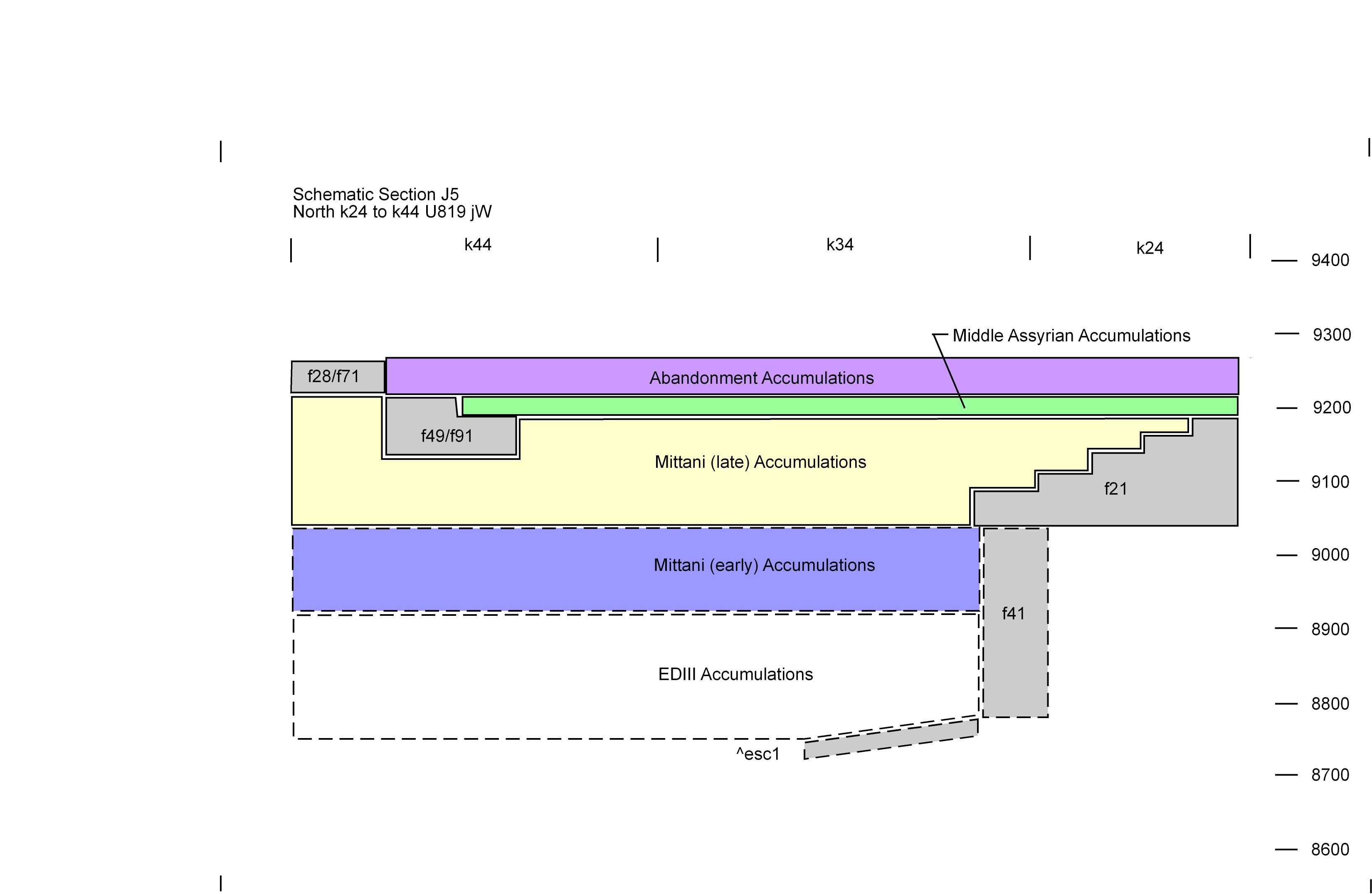
|
Back to top: Chronology
Middle Assyrian
|
There were no structures that could be definitely associated with a Middle Assyrian occupation. However, ceramics dateable to that period were found in a thin band of accumulation between the monumental stairway, f21, and the western boundary stones.
|
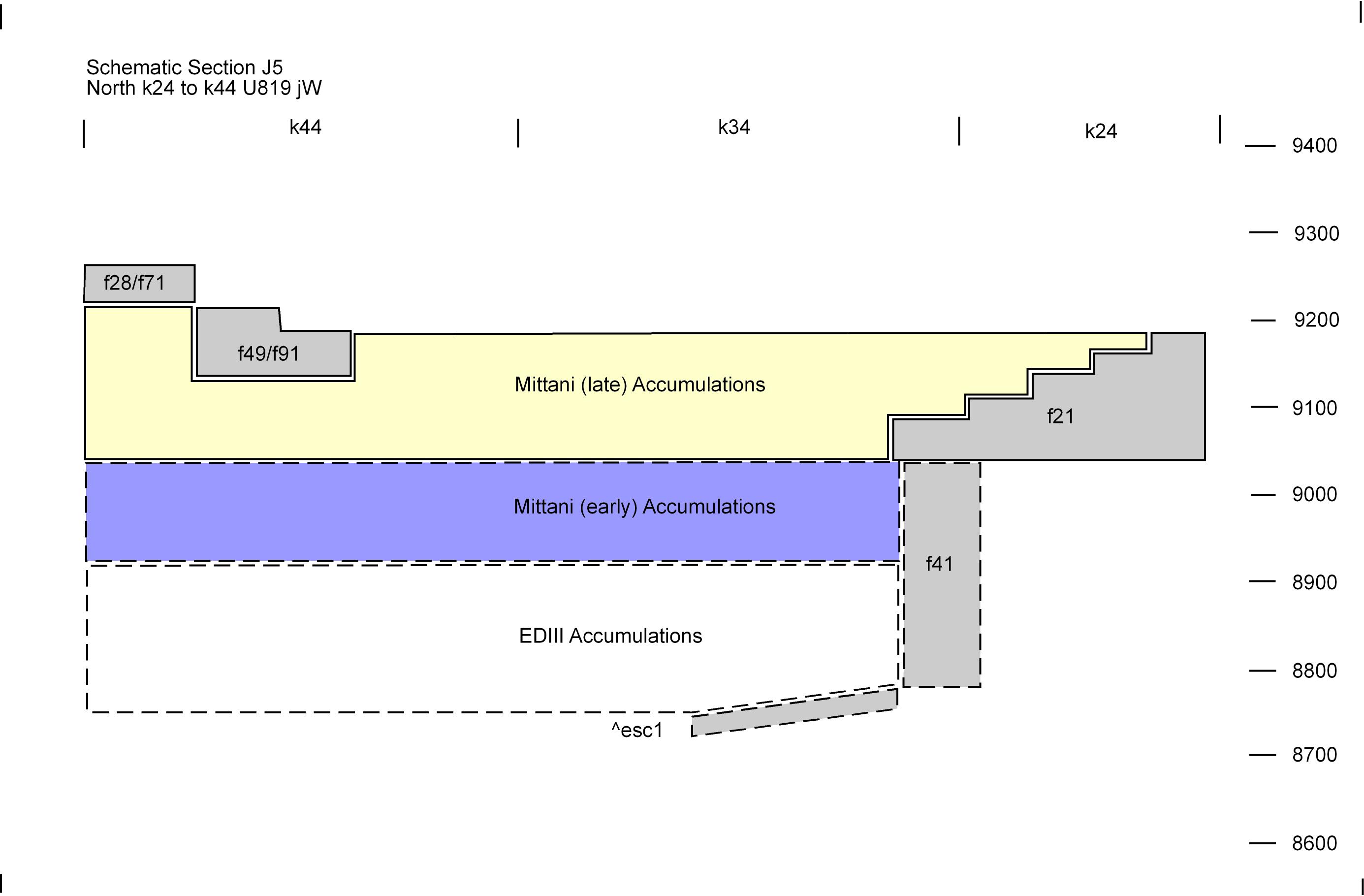
|
Back to top: Chronology
Late Mittani
|
Late in the Mittani period, even the structures of the western expansion became covered. Early in this phase a series of boundary stones, ^bdr1, was erected to delimit the western boundary of the new plaza. However, in time even these were covered with accumulation as the staircase, f21, disappeared from view.
|
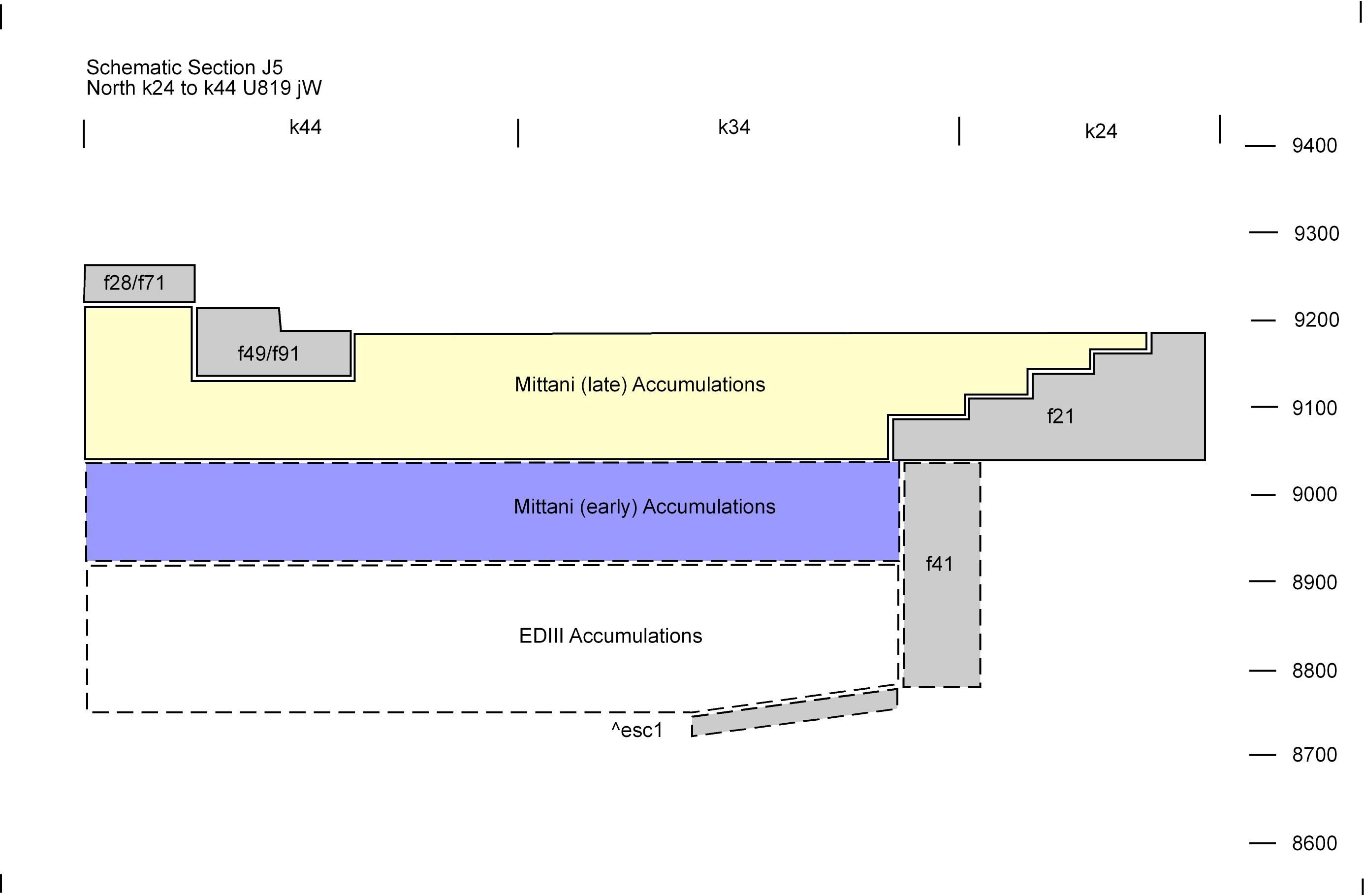
|
Back to top: Chronology
Middle Mittani period (Phases 7g to 7i-J5A): Western Expansion
North Section
In the middle of the Mittani period, the plaza, eastern stairway, and revetment wall were covered with accumulation. To maintain a sacred presence at the base of the BA temple mound, the temple access was shifted to the west. A low wall, f3; an apron, f99; a bin,^bin1; a boundary wall, possibly f196, and a monumental staircase, f21; were constructed to replicate, on a small scale, a mirror image of the covered EDIII structures.
|
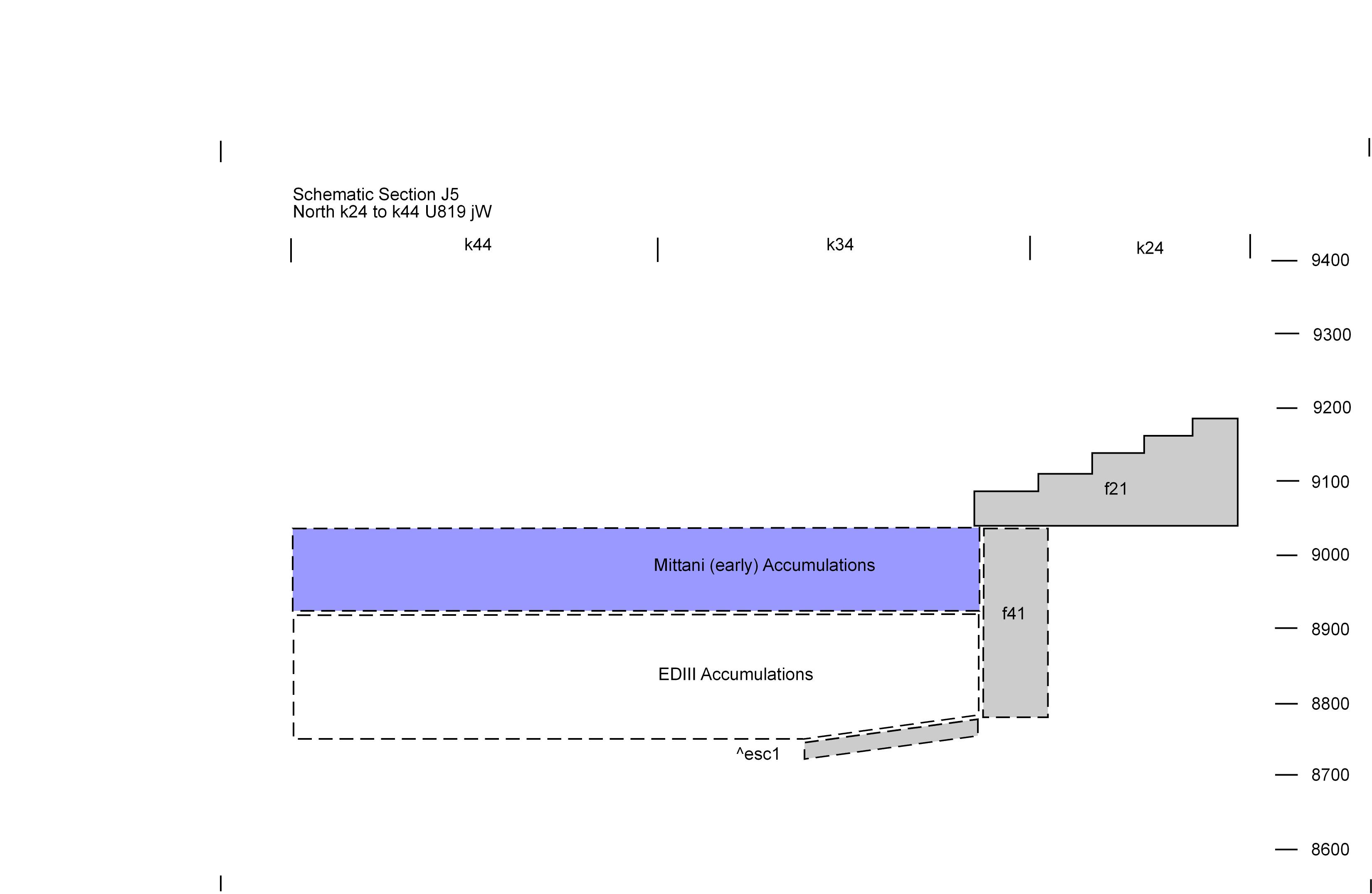
|
East Section
At the time that the Western Expansion was taking place in the northern loci, the Early Mittani structures in the eastern portion were periodically covered and partially uncovered by the action of water which was channeled between the revetment wall and what we presume to be a substantial structure to the west.
|
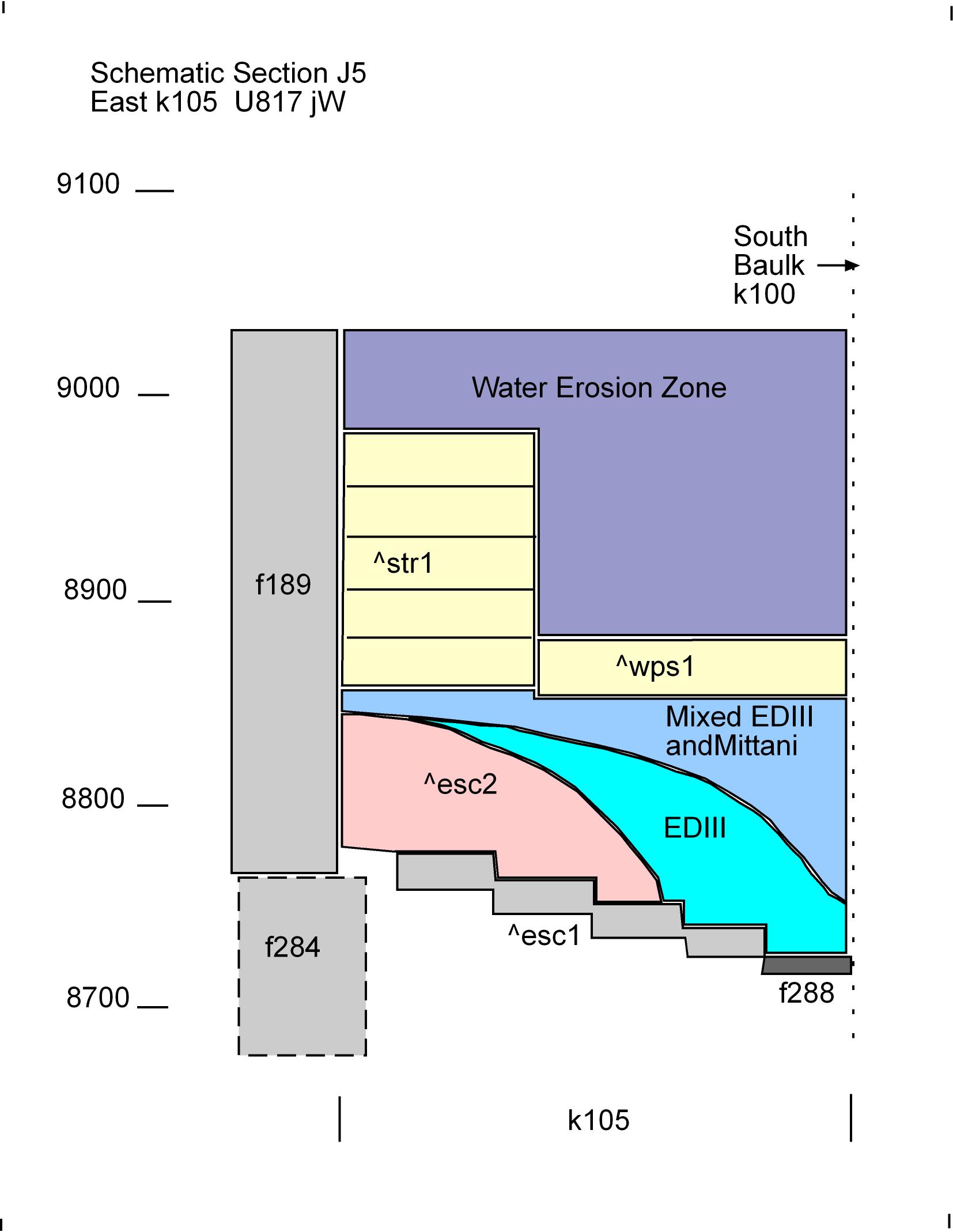
|
Back to top: Chronology
Early Mittani period (Phases 7a to 7e-J5A): Secular Use
North Section
In the northern part of J5, we have only excavated early Mittani (EM) accumulations in a limited area beside and below the bottom step of the monumental staircase, f21. In addition, we have found the top of a line of bricks, f196, which may be either pavement or a wall-top at the western end of the mini-plaza opposite f21. Otherwise, we surmise that here, as in the more deeply excavated eastern loci, EM accumulatons directly cover those of the Early Dynastic III (EDIII) period, abutting revetment wall, f41, and covering its stone escarpment.
|
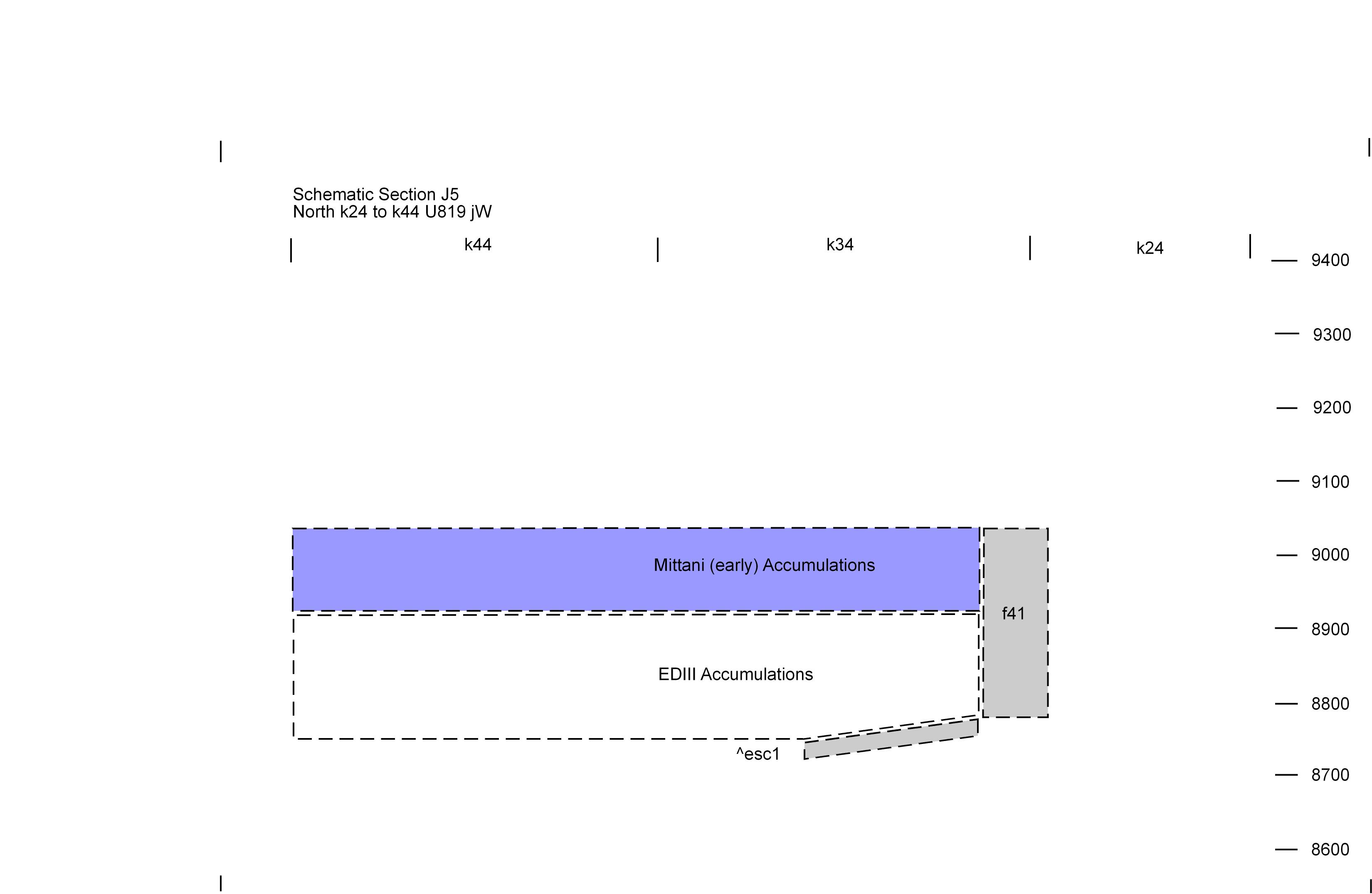
|
|
East Section
Directly atop the escarpment's EDIII accumulations and against the revetment wall, f41 and f289 were Mittani accumlations and structures. The most noteworthy are a stone stairway to the top of the revetment wall, ^strc1, and what we understand to be a stone and mudbrick dam ^eps1^, to control the flow of water along the wall. Curiously, there was no cultural material from intermediate periods present. During the long time interval that temple access was from the east and the plaza served a sacred function, evidence indicates that the area in front of the western part of the revetment wall probably was used for secular activities. One example is the manufacture of slingballs, a8. Above the dam, every accumulation shows signs of water erosion, with stream cuts filled with sand, which were then smoothed and flattened into a new surface. To the east of the dam and stairway, water flows during the Mittani period cut into and mixed with Early Dynastic period accumlations which were immediately below.
|
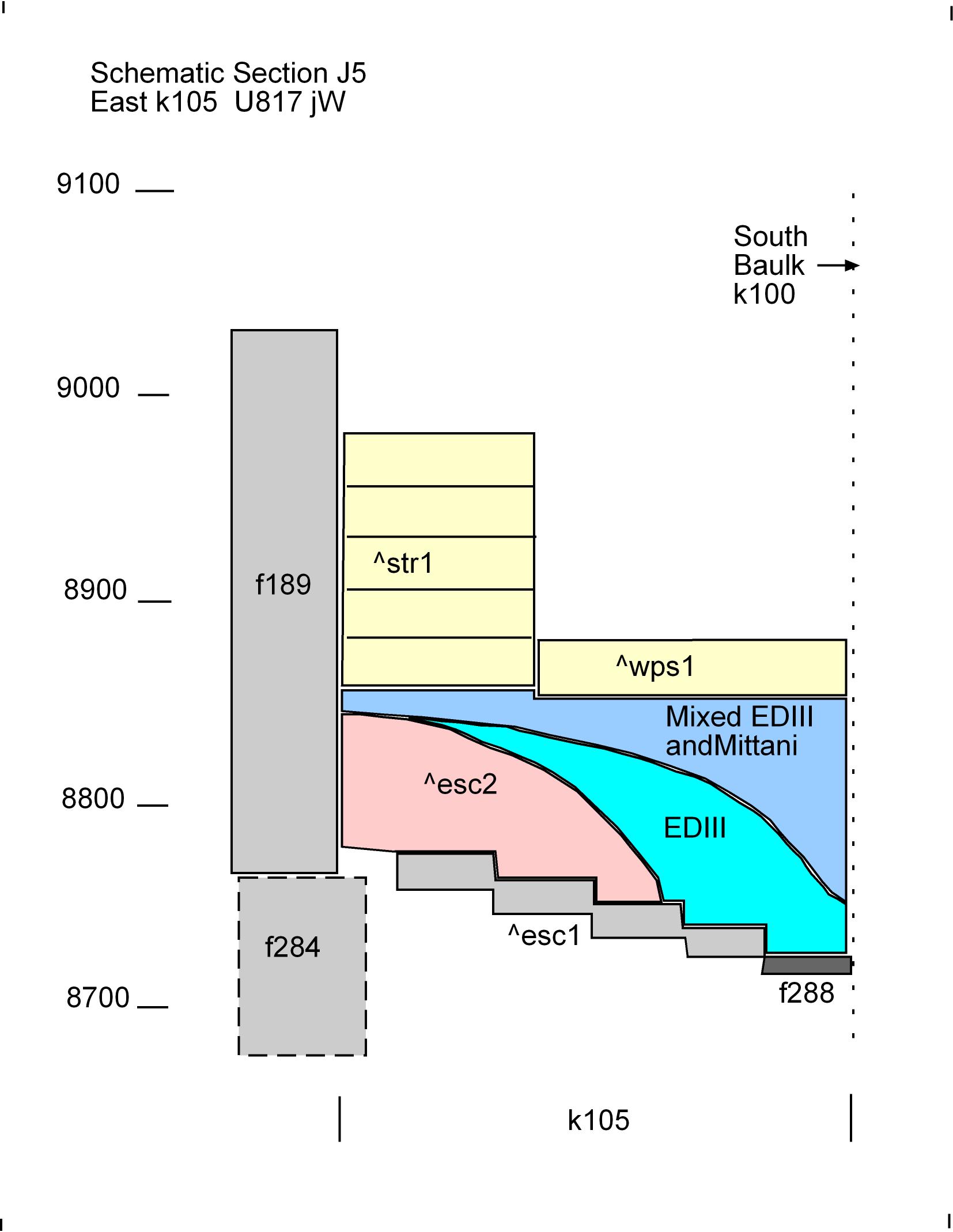
|
Back to top: Chronology
Late Early Dynastic III period (Phase 3s-J5A): Use of Escarpments
|
For an indeterminate period of time following construction of wall component, f189, and the baqaya escarpment, ^esc2, accumulations indicate that use of this area continued through the Early Dynastic period. Curiously, there is no evidence for further use until the Mittani period, even though there are ceramics from each intermediate period present in the adjacent plaza being excavated as J1.
|
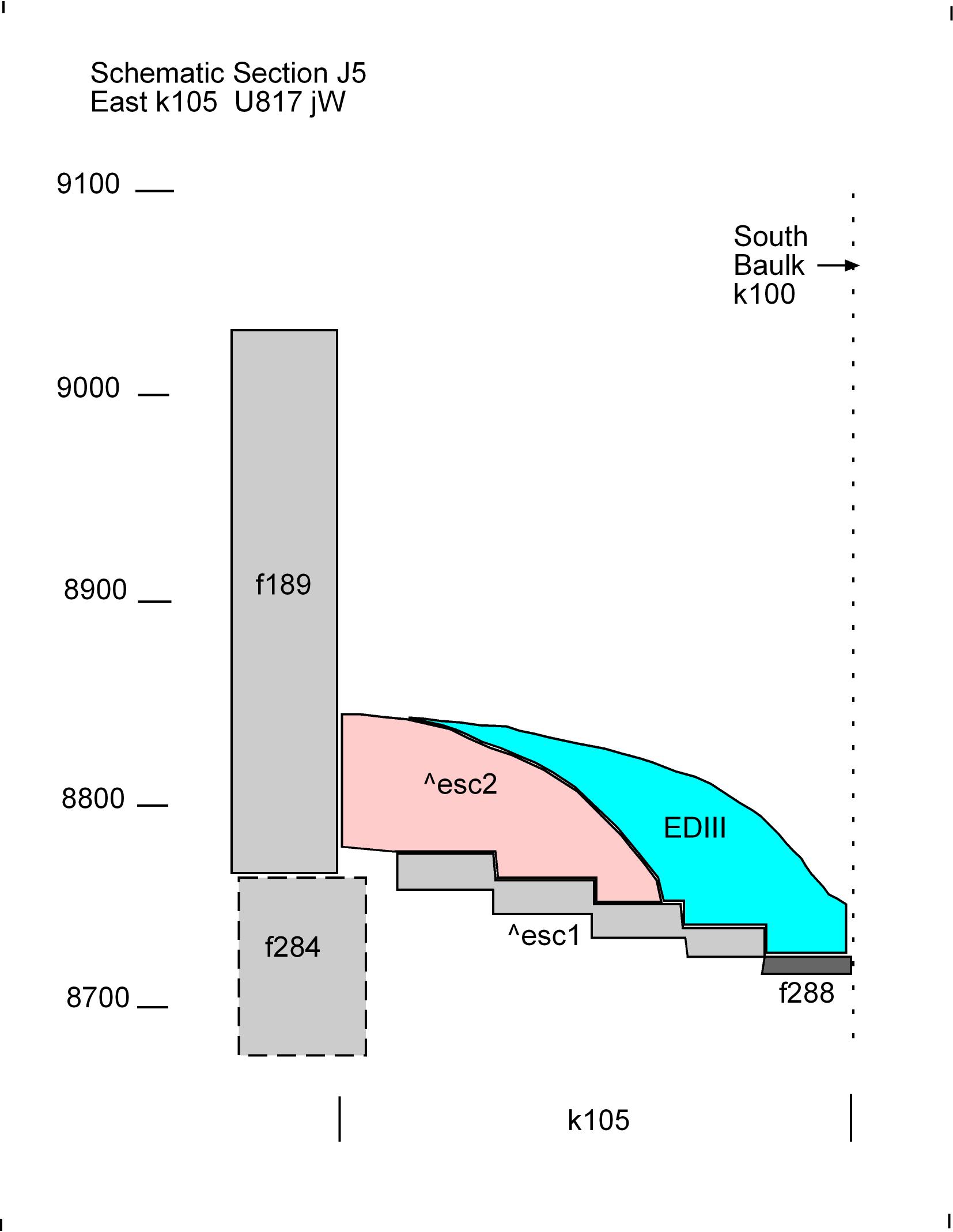
|
Back to top: Chronology
Middle Early Dynastic}{ III period Phase 3p-J5A: Rebuild of East Wall and Second Escarpment
|
Major components of the revetment wall system, wall f189, and the second, soil escarpment, ^esc2, were built and used during the EDIII period. Our understanding of the duration is inhibited by the direct overlay of Mittani material. It is possible that deposits from the intermediate periods were removed at one time just prior to the Early Mittani construction. It is also possible that the EDIII surfaces were periodically swept clean.
|

|
Back to top: Chronology
Early in Early Dynastic III period: First Escarpment and West Wall
|
The stone escarpment, ^esc1, aligns with and protects the western portion of the revetment wall, f41. However, the eastern portion of the revetment wall, f189, does not align and needed the baqaya escarpment, ^esc2
, built atop the stone one for protection. This means that f41 was built and placed in use before f189. In addition to the wall and stone escarpment, pavement, f288, probably linked to unexcavated structures to the west, was built during this period.
|
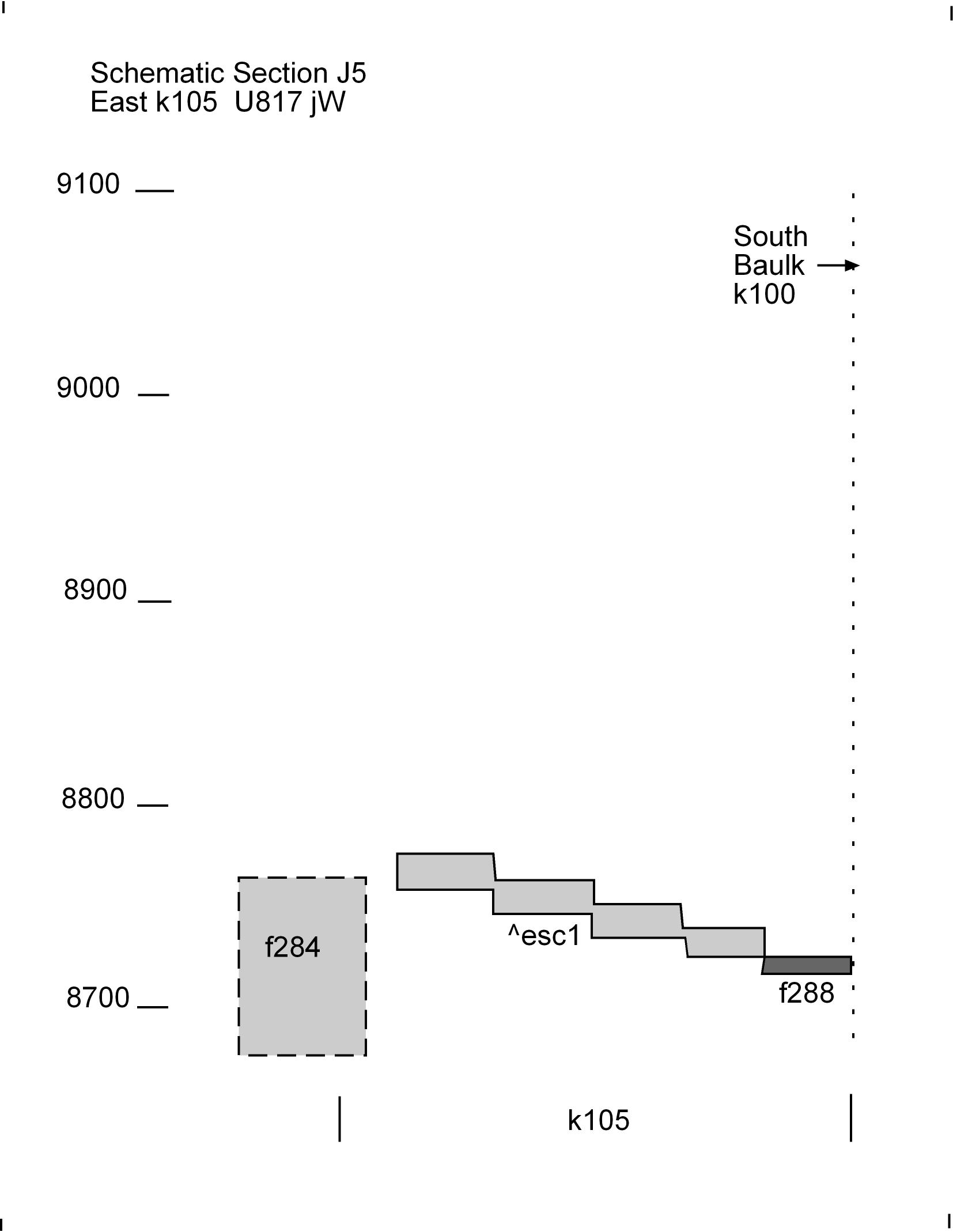
|
Back to top: Chronology
Pre-EDIII period: Earliest Wall
|
Below wall, f189, but neither aligned with it nor the stone escarpment, ^esc1, was a structure, f284, probably a wall. Thus from the stratigraphy we know that it is the earliest feature so far excavated in the unit. However, we have not recovered any typological evidence to identify the period in which it was built.
|

|
Back to top: Chronology